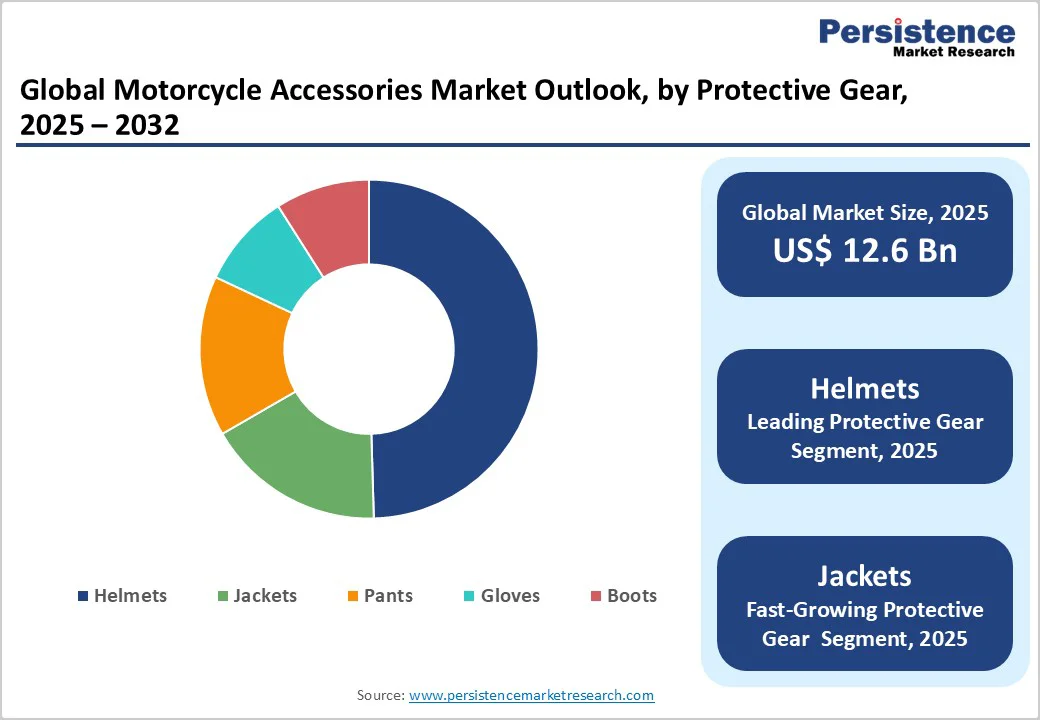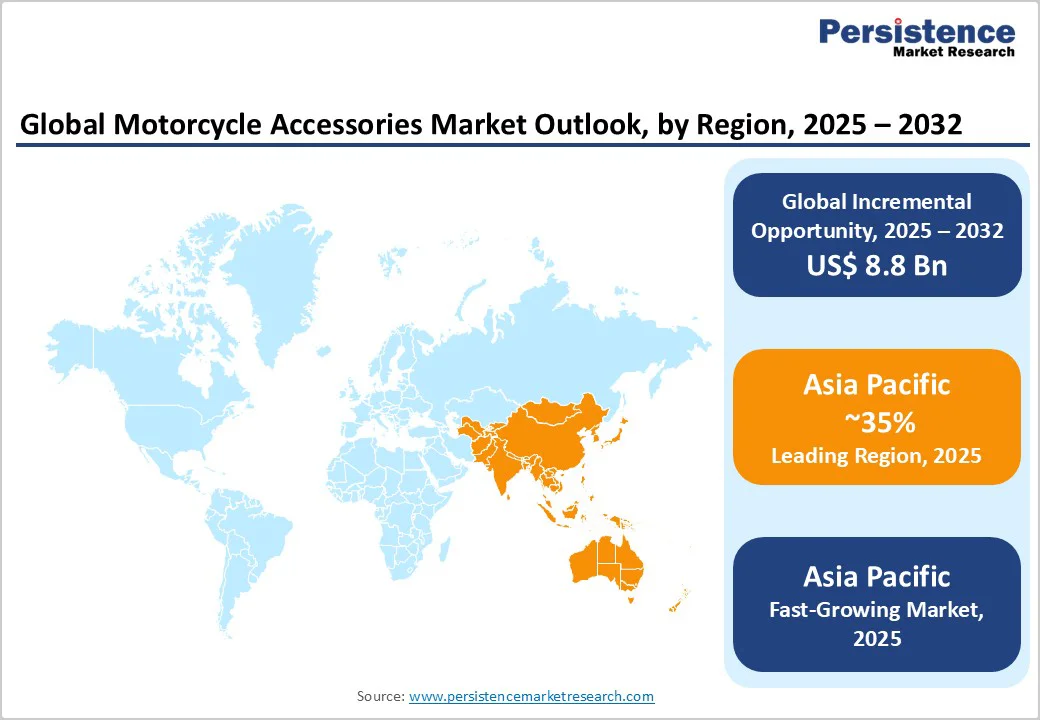ID: PMRREP11398| 197 Pages | 16 Nov 2025 | Format: PDF, Excel, PPT* | Automotive & Transportation

The global motorcycle accessories market size is likely to be valued at US$12.6 Billion in 2025 and is expected to reach US$21.4 Billion by 2032, growing at a CAGR of 7.9% during the forecast period from 2025 to 2032, driven by increasing demand for rider safety, rising adoption of performance upgrades, and advancements in customization technologies. The ability of motorcycle accessories to enhance rider protection, improve vehicle performance, and boost comfort has fueled their adoption across touring, sports, and commuter segments.
| Key Insights | Details |
|---|---|
| Motorcycle Accessories Market Size (2025E) | US$12.6 Bn |
| Market Value Forecast (2032F) | US$21.4 Bn |
| Projected Growth (CAGR 2025 to 2032) | 7.9% |
| Historical Market Growth (CAGR 2019 to 2024) | 7.1% |

The motorcycle accessories market is witnessing strong growth due to the rising focus on rider safety and vehicle customization. Increasing road accidents and awareness campaigns by governments and manufacturers have led riders to invest more in safety-oriented accessories such as helmets, gloves, jackets, guards, and advanced lighting systems. Regulatory bodies are enforcing stricter safety standards, further boosting the adoption of certified protective gear. The trend of motorcycle personalization is gaining momentum, especially among younger consumers who view bikes as lifestyle products rather than mere transportation.
Custom accessories such as exhausts, seats, decals, and handle grips allow riders to enhance performance, comfort, and aesthetics. Social media influence, along with the popularity of adventure and touring motorcycles, has also accelerated demand for premium and tech-integrated accessories, including smart helmets and GPS-enabled devices. As consumers seek a balance between safety and style, manufacturers are developing innovative, lightweight, and durable accessories. This dual demand for protection and individuality continues to shape the evolution of the global motorcycle accessories market.
The market faces challenges from elevated prices of high-end materials such as carbon fiber and advanced composites. Premium accessories such as advanced helmets, GPS systems, Bluetooth-enabled devices, and performance exhausts are often priced beyond the reach of average consumers, particularly in developing regions. These high prices stem from the use of superior materials, R&D investments, and compliance with international safety standards. Many riders opt for cheaper, unbranded, or imitation products that compromise quality and safety.
The growing presence of counterfeit accessories in online and local markets poses risks not only to riders but also to brand reputation and market stability. Fake products often lack durability, performance reliability, and safety certifications, leading to accidents or equipment failure. Counterfeit trade undermines legitimate manufacturers, reducing their profit margins and discouraging innovation. Key players are focusing on brand authentication technologies, awareness campaigns, and partnerships with authorized distributors to curb fake product circulation and maintain consumer trust in the motorcycle accessories industry.
The integration of smart technologies and sustainable materials is transforming the motorcycle accessories market, aligning it with modern consumer expectations and global sustainability goals. Riders increasingly demand connected, tech-enabled accessories such as Bluetooth communication systems, GPS trackers, smart helmets with head-up displays, and tire pressure monitoring systems that enhance safety, convenience, and performance. These innovations appeal particularly to tech-savvy urban commuters and adventure riders seeking real-time data and connectivity on the go.
Manufacturers are shifting toward eco-friendly materials, including recycled plastics, bio-based fabrics, and lightweight composites, to reduce environmental impact. This move is driven by stricter environmental regulations and the rising popularity of electric motorcycles. Sustainable helmets, vegan leather seats, and biodegradable lubricants are gaining traction among environmentally conscious consumers. Companies are also adopting energy-efficient production processes and recyclable packaging to strengthen their green image
Helmets dominate the protective gear segment, accounting for 55% share in 2025. This dominance stems from its ability to provide superior impact absorption and ventilation, making it essential for applications requiring high safety standards, such as sports and touring riding. Helmet systems, which use advanced materials such as carbon fiber to manage energy dissipation, offer superior protection and lightweight design, eliminating the need for bulky alternatives.
Jackets is the fastest-growing sub-segment, driven by its versatility and weather-resistant properties for applications where multi-season protection is critical. Jackets incorporate innovative fabrics for breathability and armor integration, without requiring additional layers. The increasing focus on all-weather riding in regions such as Europe is accelerating the adoption of jacket systems.
Exhaust Systems dominate the performance enhancements segment, commanding 35% share in 2025. Its widespread use is attributed to its ability to improve engine efficiency and sound, making it preferred for sports and cruiser motorcycles. Exhaust systems offer enhanced power output and reduced weight, with leading manufacturers such as Akropovic providing consistent performance upgrades for high-end applications.
Suspension Kits is the fastest-growing sub-segment, driven by its potential for improved handling and ride quality in off-road and adventure biking. These kits offer advantages such as adjustable damping and compatibility with various terrains, making them suitable for emerging trends in adventure tourism. Innovations in suspension technologies, such as electronic adjustments, are accelerating their adoption in next-generation motorcycles, particularly in Asia Pacific.
Reflective Vests dominate the safety equipment segment, holding 30% share in 2025. The segment’s dominance is driven by the increasing demand for visibility-enhancing gear in low-light conditions, particularly in urban commuting. Companies such as Suzuki and Honda offer advanced solutions that integrate with riding apparel, enhancing nighttime safety. The segment’s growth is further supported by global trends toward road safety regulations and the rising adoption of high-visibility equipment.
Rain Gear is the fastest-growing, fueled by the need for weatherproof solutions in variable climates. Rain gear provides waterproofing and breathability, reducing discomfort during rides. The growing use of such equipment in touring applications, particularly in Europe where weather variability is high, is driving rapid adoption. The segment’s growth is further supported by advancements in lightweight, packable materials.
Windshields dominate the comfort accessories segment, holding a 40% share in 2025. The segment’s dominance is driven by the demand for aerodynamic protection and reduced wind fatigue in long-distance riding, particularly in touring segments. Companies such as Ducati Motor Holding and KTM Company offer customizable solutions that integrate with bike designs, enhancing rider comfort. The segment’s growth is supported by the trend toward adventure biking and extended trips.
Travel Bags are the fastest-growing, fueled by the integration of storage solutions in motorcycle tourism. Travel bags offer durability, weather resistance, and easy mounting, improving convenience. The growing use of bags in adventure and commuting, particularly in Asia Pacific where motorcycle travel is prevalent, is driving rapid adoption. The segment’s growth is further supported by innovations in modular, expandable designs.

Asia Pacific dominates commands 35%, driven by rising disposable incomes, urbanization, and the expanding motorcycling community across India, China, Indonesia, and other emerging economies. Increasing motorcycle ownership has boosted demand for safety gear such as helmets, gloves, and jackets, along with performance and aesthetic upgrades such as exhaust systems, custom seats, and LED lighting. The popularity of e-commerce platforms has made premium and aftermarket accessories more accessible to consumers, fueling personalization trends among younger riders.
The rise of electric two-wheelers is also reshaping the market, with growing demand for lightweight components, battery chargers, and EV-compatible accessories. Tech-savvy consumers are embracing Bluetooth-enabled helmets, navigation systems, and smart communication devices that enhance convenience and safety. Despite strong growth prospects, price sensitivity and inconsistent safety regulations across the region remain key challenges.
North America holds 25% share in 2025, characterized by strong consumer interest in safety, customization, and advanced technology. Riders are increasingly investing in premium protective gear such as helmets, gloves, jackets, and boots, driven by growing awareness of road safety and stringent regulatory standards. The region also showcases a vibrant customization culture, with enthusiasts seeking aftermarket performance parts, exhaust systems, and aesthetic upgrades to enhance both functionality and style.
Technological integration is another defining trend, as smart helmets, Bluetooth communication systems, and camera-equipped accessories gain popularity among tech-savvy riders. With high disposable incomes and a well-developed retail network, North American consumers are more inclined toward premium and branded products that offer superior comfort, durability, and innovation. The popularity of touring and adventure biking has boosted demand for luggage systems, navigation aids, and ergonomic accessories. Inflationary pressures and rising financing costs for new motorcycles may slightly temper growth.
Europe accounts 20% share in 2025, supported by strong regulatory frameworks and rider communities. Stringent safety regulations and growing rider awareness are driving demand for advanced protective gear, including helmets, jackets, and gloves equipped with smart sensors and connectivity features. The region’s vibrant touring and adventure motorcycling culture, particularly in Germany, Italy, and France, is fueling demand for performance-enhancing accessories such as luggage systems, upgraded lighting, and customized parts.
The rapid expansion of e-commerce and direct-to-consumer sales channels allows riders to easily access a wide range of premium and personalized accessories online. Sustainability is becoming a key differentiator, with manufacturers increasingly using recycled materials, eco-friendly production methods, and developing accessories tailored for electric motorcycles. European consumers’ preference for quality and innovation supports the growth of premium brands, although high prices and counterfeit products continue to challenge the market.

The global motorcycle accessories market is highly competitive, characterized by the presence of numerous international and regional players striving to strengthen their market position through innovation and strategic collaborations. Leading companies are focusing on product diversification to cater to the diverse needs of riders, ranging from safety gear and performance parts to smart, connected, and eco-friendly accessories.
The growing popularity of e-commerce platforms has further intensified competition, prompting manufacturers to form partnerships with online retailers such as Amazon, Flipkart, and Alibaba to expand their digital presence and reach a broader customer base. Sustainability has become a key differentiator, with brands increasingly adopting recycled materials, biodegradable packaging, and energy-efficient production methods to align with global environmental goals.
Key Industry Developments
The global Motorcycle Accessories market is projected to reach US$12.6 Billion in 2025.
The market is driven by increasing focus on rider safety and vehicle customization amid global motorcycle proliferation.
The market is expected to grow at a CAGR of 7.9% from 2025 to 2032.
The integration of smart technologies and sustainable materials presents significant expansion opportunities.
Akropovic, Bajaj Auto, Suzuki, Honda Motor, and KTM Company are among the key players.
| Report Attribute | Details |
|---|---|
| Historical Data/Actuals | 2019 – 2024 |
| Forecast Period | 2025 – 2032 |
| Market Analysis | Value: US$ Bn |
| Geographical Coverage |
|
| Segmental Coverage |
|
| Competitive Analysis |
|
| Report Highlights |
|
By Protective Gear
By Performance Enhancements
By Safety Equipment
By Comfort Accessories
By Region
Delivery Timelines
For more information on this report and its delivery timelines please get in touch with our sales team.
About Author